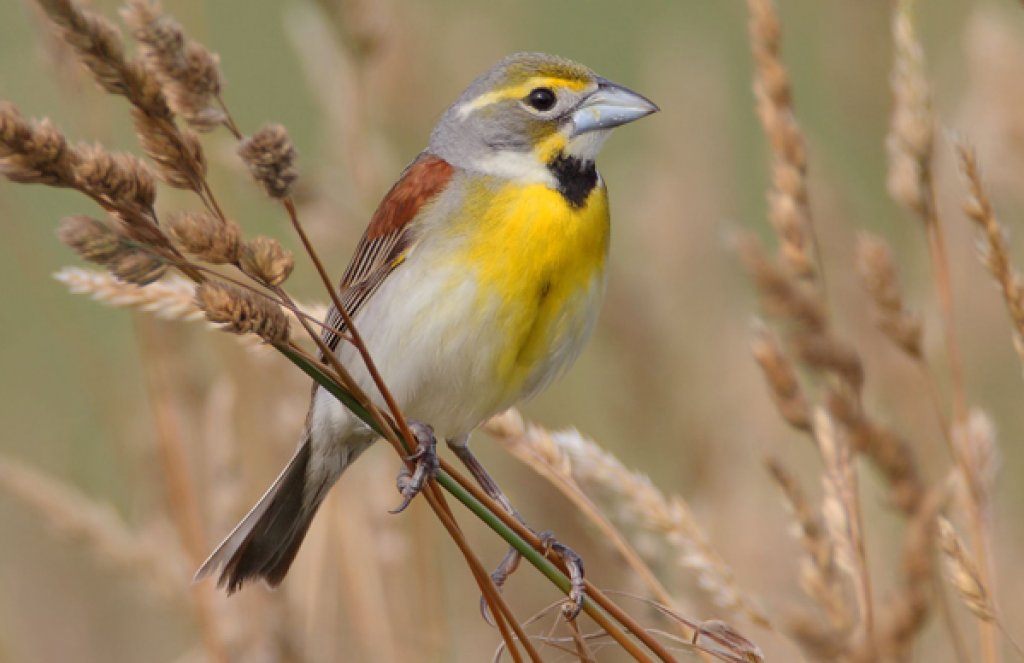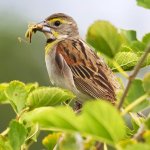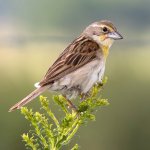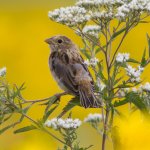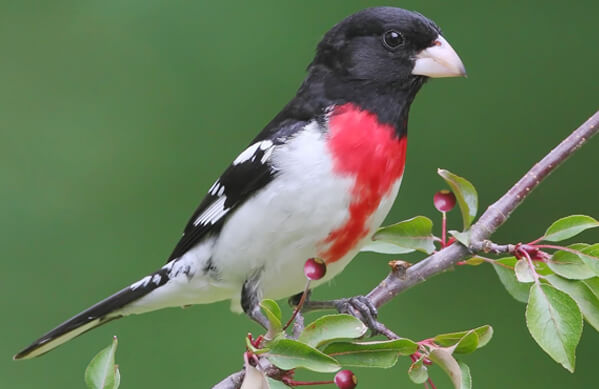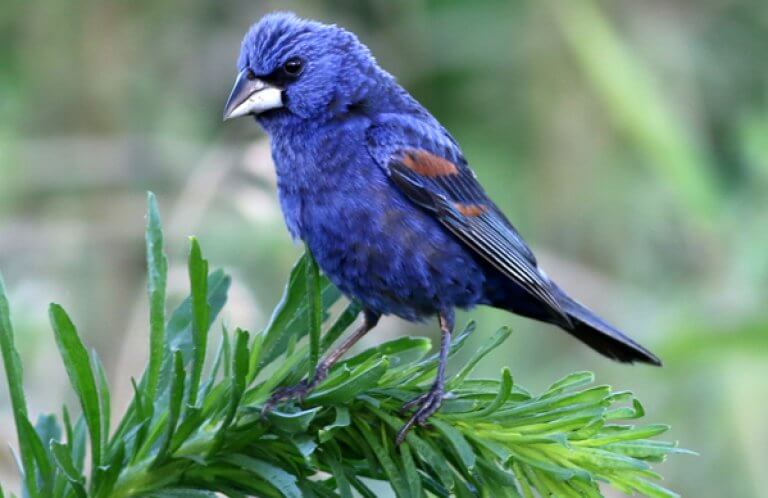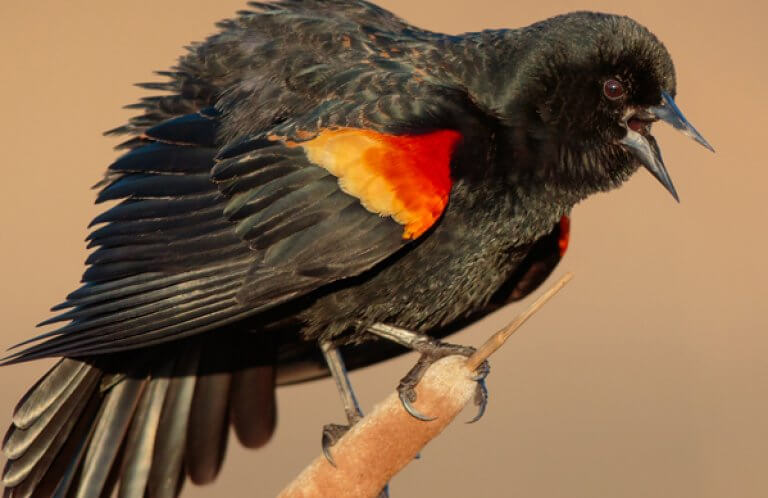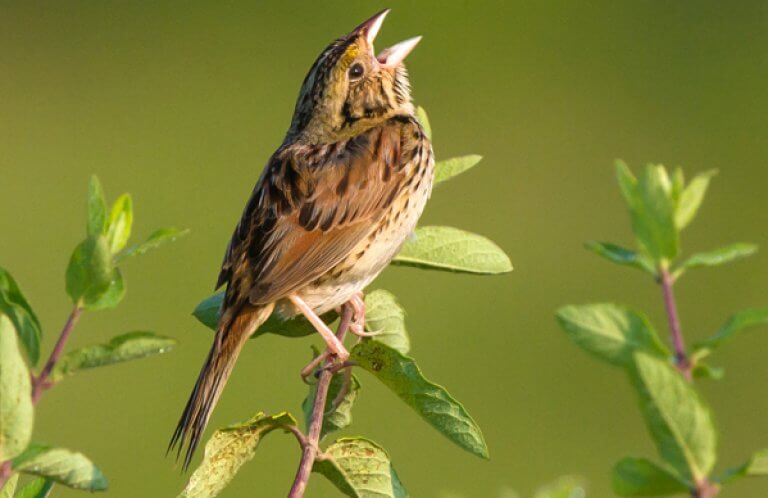About
The male Dickcissel resembles a big sparrow or miniature meadowlark, with a black, V-shaped throat patch contrasting its bright yellow breast. The female is duller overall, lacking the throat patch and having only a faint hint of yellow on the chest. Both sexes have a large, thick bill resembling that of a Northern Cardinal or Rose-breasted Grosbeak.
This species was once known as the “Black-throated Bunting,” although it's not closely related to either the “Old World” bunting species of Eurasia or “New World” buntings in the genus Passerina, such as the Blue Grosbeak or Indigo Bunting. In fact, the Dickcissel continues to confound ornithologists' efforts to find a perfect perch for this species on the “family tree” of songbirds.
A Genus All Its Own
While the Dickcissel is currently included in the cardinal family (Cardinalidae), it continues to stump scientists trying to determine its closest relatives. In the past, it had been considered part of the New World sparrow and blackbird families. For now, it is considered a monotypic species in a genus (Spiza) of its own, with no close relatives.
Songs and Sounds
This bird is named for its loud, persistent song. The typical song sounds like “dick-dick-ciss-ciss-ciss,” but there are variations. The Dickcissel's short, sharp flight call sounds somewhat like an electric buzzer.
Listen to the Dickcissel's song:
And the call here:
Breeding and Feeding
Part-time Granivores
Dickcissels forage on the ground, or by perching on stalks to pluck seeds. During the breeding season, they are omnivorous, taking seeds and also spiders and insects including grasshoppers. During winter and while migrating, they switch to a predominantly granivorous (grain-eating) diet.
Managing Multiple Mates
Like the Red-winged Blackbird, the Dickcissel is a polygynous species, with one male mating with multiple females. A male Dickcissel will defend a territory that contains both suitable nesting and foraging areas, and may have up to six females nesting in his territory, although most attract only one or two. Males with territories containing the best nest sites attract more females.
Male Dickcissels continue to defend their territories while the female(s) that take up residence select nest sites, build the nests, then brood and raise the young. The nest, a bulky cup of weeds and grass stems, is built on or slightly above the ground, in dense vegetation or in a small shrub or tree. The female incubates her clutch of three to six pale-blue eggs for 12 to 13 days. After the nestlings hatch, she feeds them a variety of invertebrates until they are ready to leave the nest.
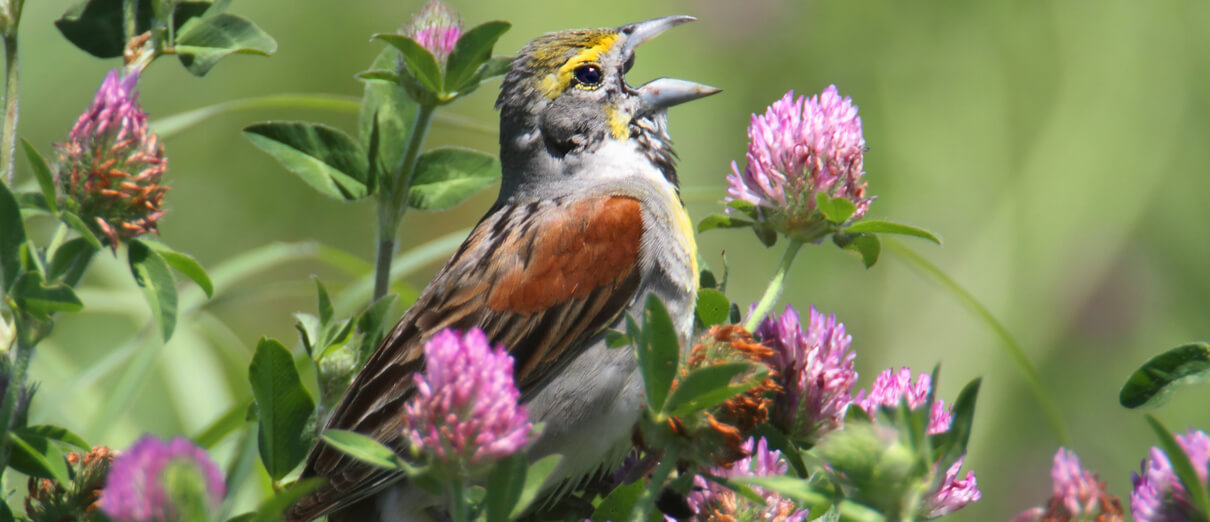
Region and Range
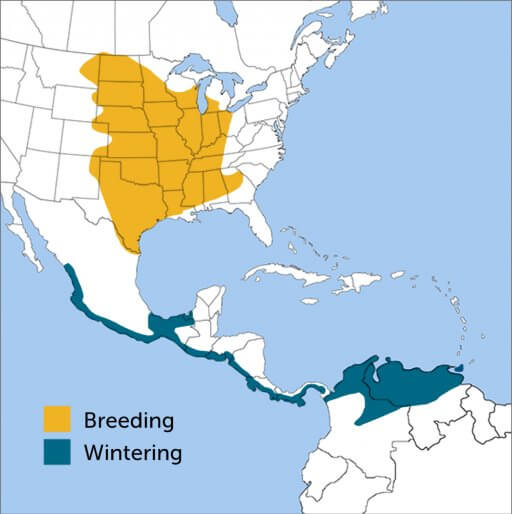
The Dickcissel breeds in the central U.S. and far south-central Canada, then migrates to Mexico, Central America, and northern South America for the winter. This bird is known to be a notorious wanderer, appearing in large numbers in suitable breeding habitats one year, only to be absent the next.
On migration and during the winter, the Dickcissel forms large flocks, some so large that they may contain 10- to 30 percent of the global population. These large flocks can damage rice and sorghum crops, and farmers use noise-making aids including cannons, bottle rockets, or banging pots and pans to scare flocks away from their fields. A few farmers deliberately poison Dickcissels during the winter, although many conservation groups have worked with farmers to find alternatives to poisoning.
Conservation
Work to Keep Dickcissels Singing
While the overall Dickcissel population is still large and likely stable overall, the species has shown significant declines in many states. Like other grassland species such as the Henslow's Sparrow and Loggerhead Shrike, the Dickcissel has been impacted by habitat loss and pesticide use. Dickcissels also risk collision with towers, turbines, and glass during their nocturnal migrations.
ABC is working with landowners, agencies, and a variety of programs, including Migratory Bird Joint Ventures, to conserve habitat for Dickcissels. Our BirdScapes program, which aims to restore breeding, wintering, and stopover habitat for migratory birds, provides another boost for this species.
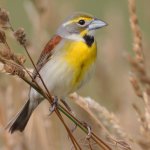
Help support ABC's conservation mission!
ABC is advocating for measures to be included in the latest Farm Bill that have the best chance of helping U.S. grassland bird species rebound. The recommendations included in ABC's “Bird Saver" platform would help the Farm Bill channel funds designated for conservation to the programs that would make the biggest difference for grasslands.
We joined with partners to file suit against the Environmental Protection Agency (EPA) in 2016, alleging insufficient federal regulation of neonicotinoid pesticides, which are toxic to birds, bees, and other wildlife. Despite increasing evidence that “neonics” are lethal to grassland birds and pollinators, the EPA recently denied a petition request from ABC and partners to change a regulatory loophole that allows continued use of seeds coated with the pesticides.
In February, Public Employees for Environmental Responsibility (PEER) and ABC spearheaded a regulatory filing with the EPA on behalf of 65 nonprofit groups. The filing proposes major reforms in the way the agency regulates systemic insecticides, particularly neonicotinoids.
Get Involved
Policies enacted by the U.S. Congress and federal agencies, such as the U.S. Fish and Wildlife Service, have a huge impact on migratory birds. You can help shape these rules for the better by urging lawmakers to prioritize birds, bird habitat, and bird-friendly measures. To get started, visit ABC's Action Center.
Living a bird-friendly life can have an immediate impact on migratory birds in the United States. Doing so can be as easy as adding native plants to your garden, avoiding pesticides, and keeping cats indoors. To learn more, visit our Bird-Friendly Life page.
American Bird Conservancy and our Migratory Bird Joint Venture partners have improved conservation management on more than 8.5 million acres of U.S. bird habitat — an area larger than the state of Maryland — over the last ten years. That's not all: With the help of international partners, we've established a network of more than 100 areas of priority bird habitat across the Americas, helping to ensure that birds' needs are met during all stages of their lifecycles. These are monumental undertakings, requiring the support of many, and you can help by making a gift today.





































